University Financial Accounting Homework: Comprehensive Analysis
VerifiedAdded on 2020/04/21
|8
|998
|50
Homework Assignment
AI Summary
This financial accounting assignment addresses several key concepts, including the treatment of book sales income, depreciation calculations, and the differences between cash and accrual accounting. It provides a statement of cash flows, analyzes cash flow stress, and examines liquidity, profitability, and solvency ratios. The assignment also covers budgeting, cost calculations, and creditor turnover, offering a comprehensive overview of financial accounting principles. The solution includes detailed calculations and explanations, making it a valuable resource for students studying finance and accounting. It also explores the implications of various financial decisions and provides insights into best practices for financial management.
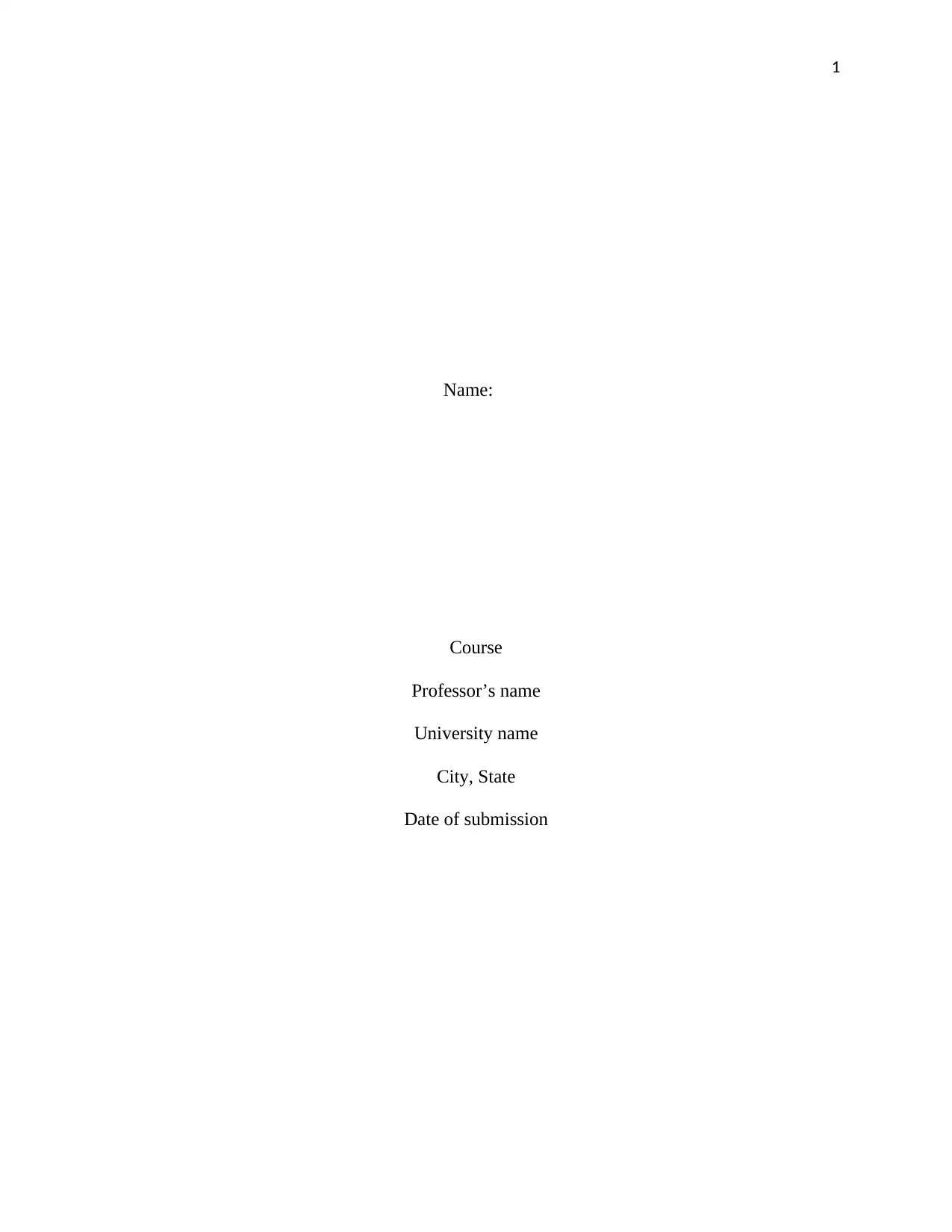
1
Name:
Course
Professor’s name
University name
City, State
Date of submission
Name:
Course
Professor’s name
University name
City, State
Date of submission
Paraphrase This Document
Need a fresh take? Get an instant paraphrase of this document with our AI Paraphraser
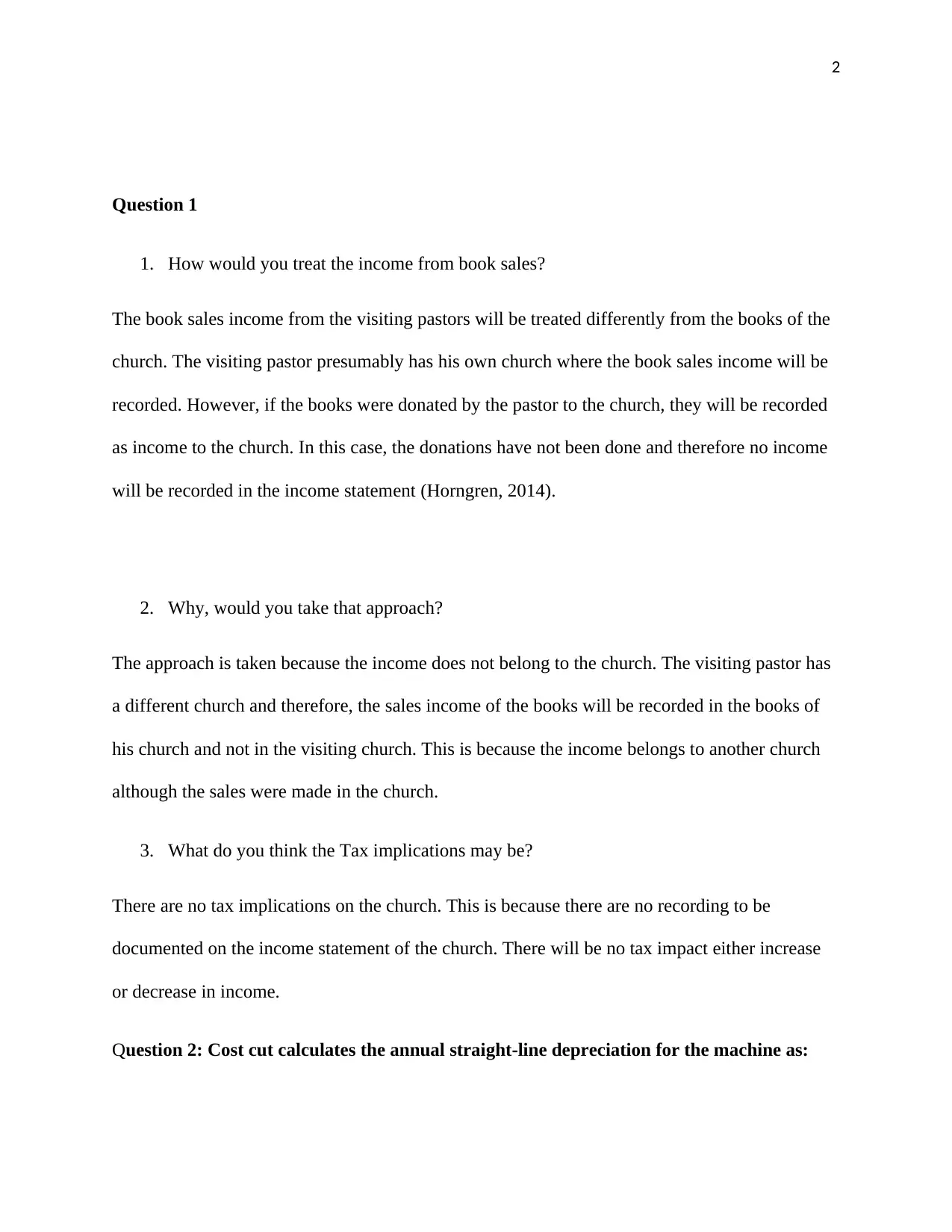
2
Question 1
1. How would you treat the income from book sales?
The book sales income from the visiting pastors will be treated differently from the books of the
church. The visiting pastor presumably has his own church where the book sales income will be
recorded. However, if the books were donated by the pastor to the church, they will be recorded
as income to the church. In this case, the donations have not been done and therefore no income
will be recorded in the income statement (Horngren, 2014).
2. Why, would you take that approach?
The approach is taken because the income does not belong to the church. The visiting pastor has
a different church and therefore, the sales income of the books will be recorded in the books of
his church and not in the visiting church. This is because the income belongs to another church
although the sales were made in the church.
3. What do you think the Tax implications may be?
There are no tax implications on the church. This is because there are no recording to be
documented on the income statement of the church. There will be no tax impact either increase
or decrease in income.
Question 2: Cost cut calculates the annual straight-line depreciation for the machine as:
Question 1
1. How would you treat the income from book sales?
The book sales income from the visiting pastors will be treated differently from the books of the
church. The visiting pastor presumably has his own church where the book sales income will be
recorded. However, if the books were donated by the pastor to the church, they will be recorded
as income to the church. In this case, the donations have not been done and therefore no income
will be recorded in the income statement (Horngren, 2014).
2. Why, would you take that approach?
The approach is taken because the income does not belong to the church. The visiting pastor has
a different church and therefore, the sales income of the books will be recorded in the books of
his church and not in the visiting church. This is because the income belongs to another church
although the sales were made in the church.
3. What do you think the Tax implications may be?
There are no tax implications on the church. This is because there are no recording to be
documented on the income statement of the church. There will be no tax impact either increase
or decrease in income.
Question 2: Cost cut calculates the annual straight-line depreciation for the machine as:
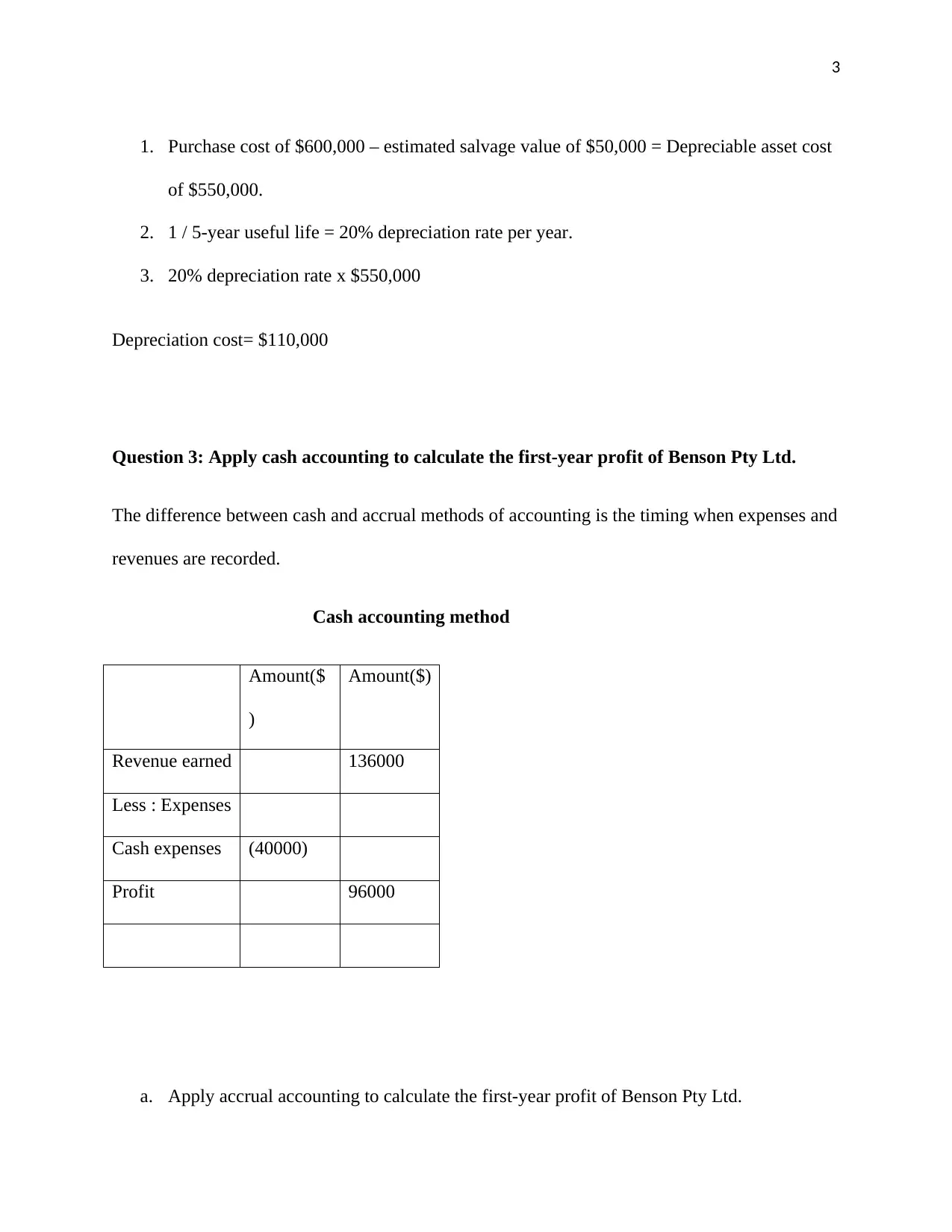
3
1. Purchase cost of $600,000 – estimated salvage value of $50,000 = Depreciable asset cost
of $550,000.
2. 1 / 5-year useful life = 20% depreciation rate per year.
3. 20% depreciation rate x $550,000
Depreciation cost= $110,000
Question 3: Apply cash accounting to calculate the first-year profit of Benson Pty Ltd.
The difference between cash and accrual methods of accounting is the timing when expenses and
revenues are recorded.
Cash accounting method
Amount($
)
Amount($)
Revenue earned 136000
Less : Expenses
Cash expenses (40000)
Profit 96000
a. Apply accrual accounting to calculate the first-year profit of Benson Pty Ltd.
1. Purchase cost of $600,000 – estimated salvage value of $50,000 = Depreciable asset cost
of $550,000.
2. 1 / 5-year useful life = 20% depreciation rate per year.
3. 20% depreciation rate x $550,000
Depreciation cost= $110,000
Question 3: Apply cash accounting to calculate the first-year profit of Benson Pty Ltd.
The difference between cash and accrual methods of accounting is the timing when expenses and
revenues are recorded.
Cash accounting method
Amount($
)
Amount($)
Revenue earned 136000
Less : Expenses
Cash expenses (40000)
Profit 96000
a. Apply accrual accounting to calculate the first-year profit of Benson Pty Ltd.
⊘ This is a preview!⊘
Do you want full access?
Subscribe today to unlock all pages.

Trusted by 1+ million students worldwide
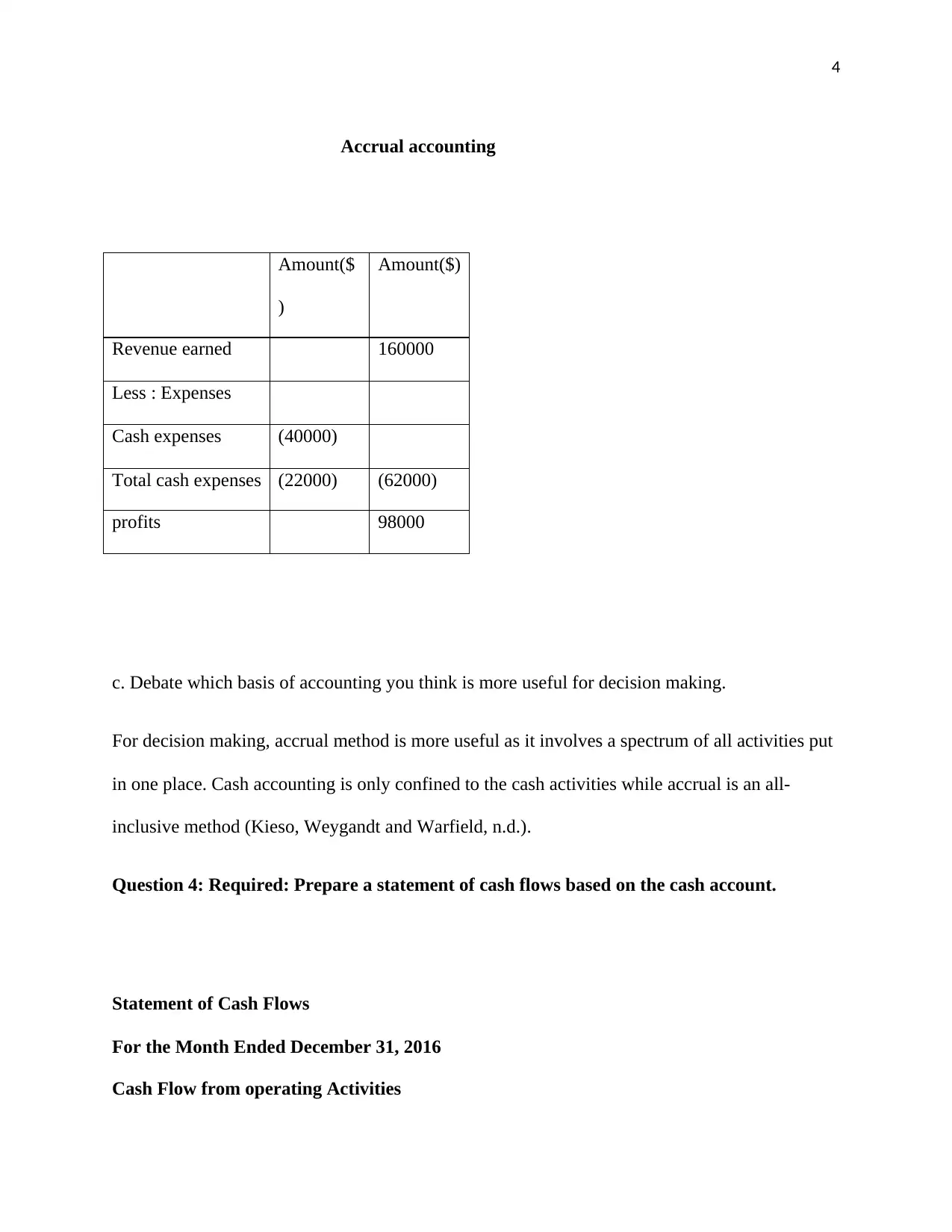
4
Accrual accounting
Amount($
)
Amount($)
Revenue earned 160000
Less : Expenses
Cash expenses (40000)
Total cash expenses (22000) (62000)
profits 98000
c. Debate which basis of accounting you think is more useful for decision making.
For decision making, accrual method is more useful as it involves a spectrum of all activities put
in one place. Cash accounting is only confined to the cash activities while accrual is an all-
inclusive method (Kieso, Weygandt and Warfield, n.d.).
Question 4: Required: Prepare a statement of cash flows based on the cash account.
Statement of Cash Flows
For the Month Ended December 31, 2016
Cash Flow from operating Activities
Accrual accounting
Amount($
)
Amount($)
Revenue earned 160000
Less : Expenses
Cash expenses (40000)
Total cash expenses (22000) (62000)
profits 98000
c. Debate which basis of accounting you think is more useful for decision making.
For decision making, accrual method is more useful as it involves a spectrum of all activities put
in one place. Cash accounting is only confined to the cash activities while accrual is an all-
inclusive method (Kieso, Weygandt and Warfield, n.d.).
Question 4: Required: Prepare a statement of cash flows based on the cash account.
Statement of Cash Flows
For the Month Ended December 31, 2016
Cash Flow from operating Activities
Paraphrase This Document
Need a fresh take? Get an instant paraphrase of this document with our AI Paraphraser
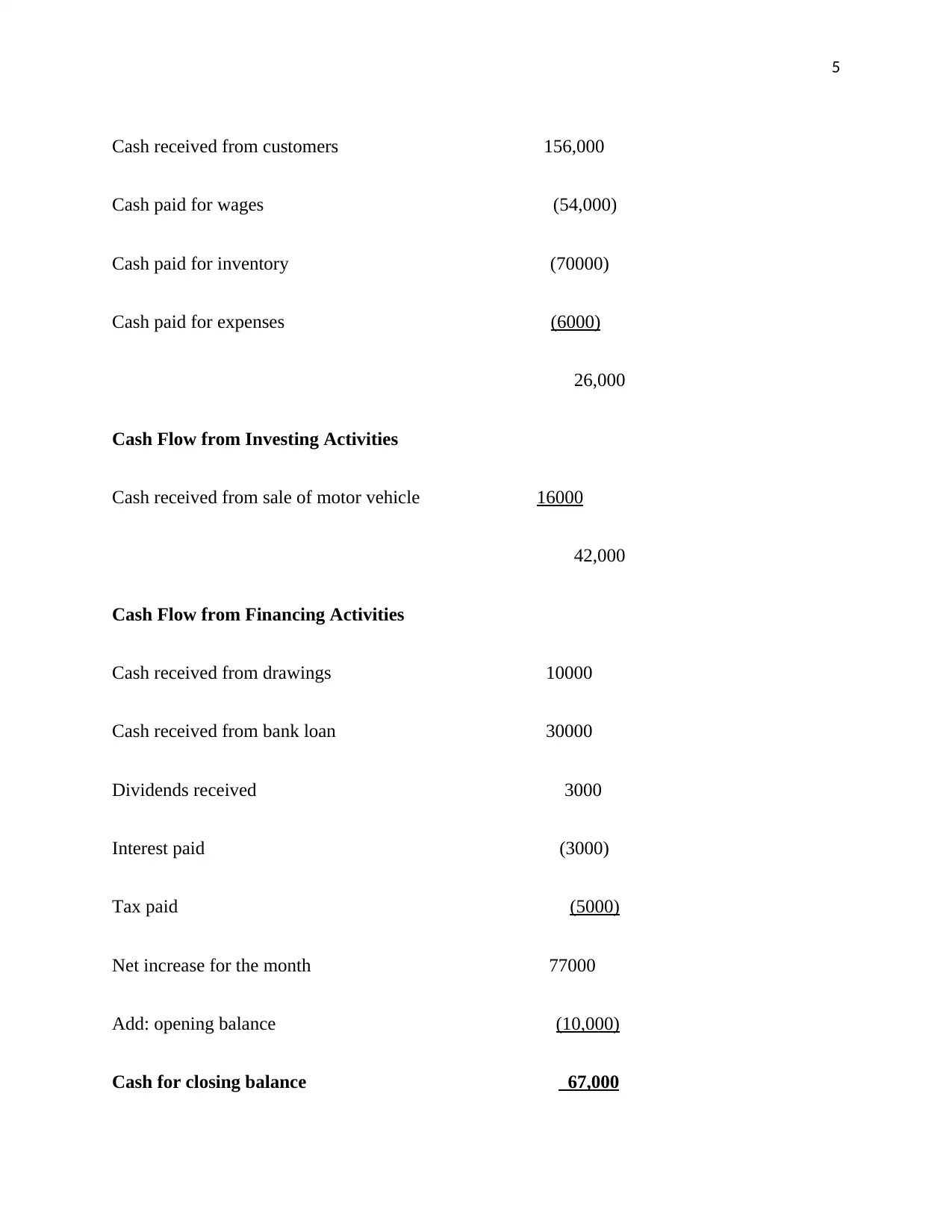
5
Cash received from customers 156,000
Cash paid for wages (54,000)
Cash paid for inventory (70000)
Cash paid for expenses (6000)
26,000
Cash Flow from Investing Activities
Cash received from sale of motor vehicle 16000
42,000
Cash Flow from Financing Activities
Cash received from drawings 10000
Cash received from bank loan 30000
Dividends received 3000
Interest paid (3000)
Tax paid (5000)
Net increase for the month 77000
Add: opening balance (10,000)
Cash for closing balance 67,000
Cash received from customers 156,000
Cash paid for wages (54,000)
Cash paid for inventory (70000)
Cash paid for expenses (6000)
26,000
Cash Flow from Investing Activities
Cash received from sale of motor vehicle 16000
42,000
Cash Flow from Financing Activities
Cash received from drawings 10000
Cash received from bank loan 30000
Dividends received 3000
Interest paid (3000)
Tax paid (5000)
Net increase for the month 77000
Add: opening balance (10,000)
Cash for closing balance 67,000
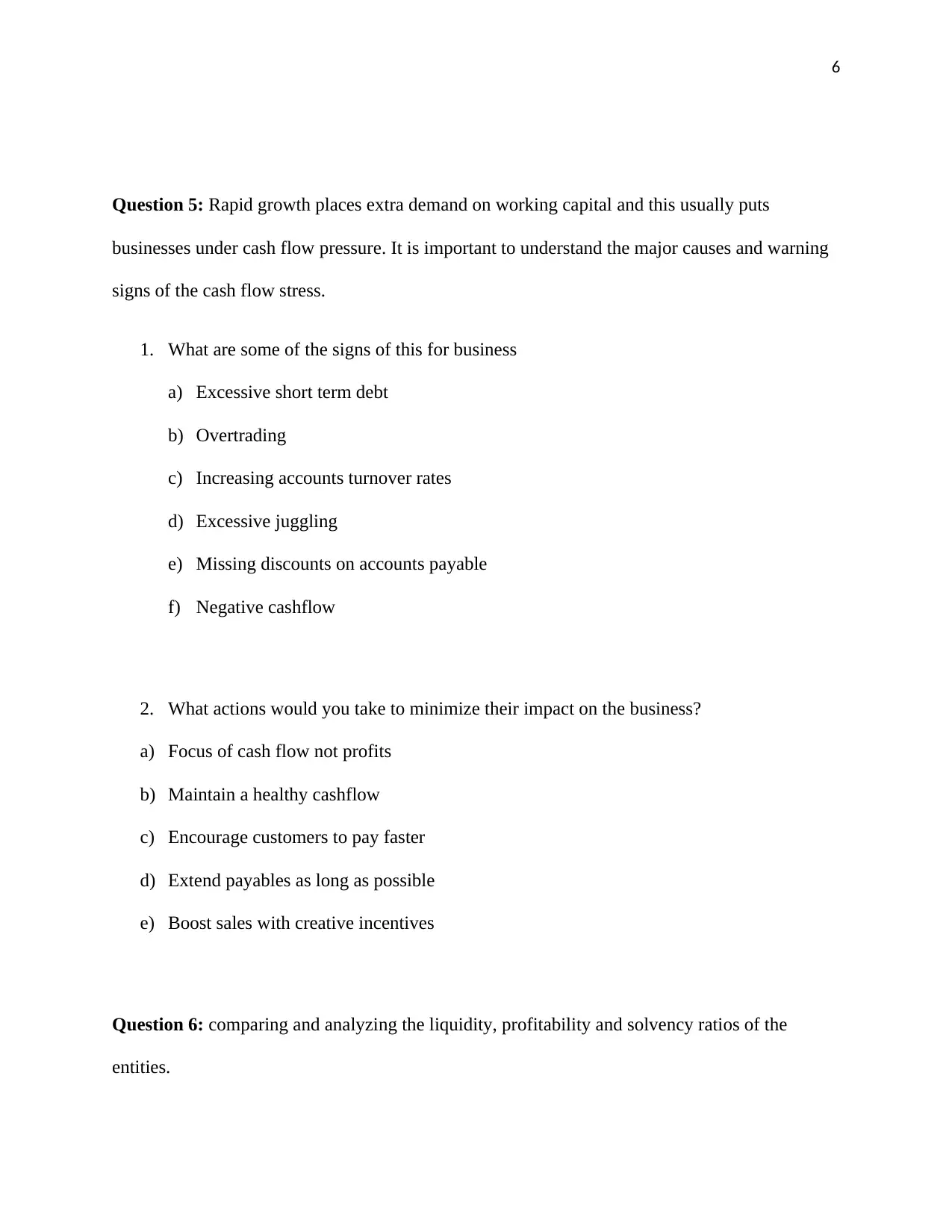
6
Question 5: Rapid growth places extra demand on working capital and this usually puts
businesses under cash flow pressure. It is important to understand the major causes and warning
signs of the cash flow stress.
1. What are some of the signs of this for business
a) Excessive short term debt
b) Overtrading
c) Increasing accounts turnover rates
d) Excessive juggling
e) Missing discounts on accounts payable
f) Negative cashflow
2. What actions would you take to minimize their impact on the business?
a) Focus of cash flow not profits
b) Maintain a healthy cashflow
c) Encourage customers to pay faster
d) Extend payables as long as possible
e) Boost sales with creative incentives
Question 6: comparing and analyzing the liquidity, profitability and solvency ratios of the
entities.
Question 5: Rapid growth places extra demand on working capital and this usually puts
businesses under cash flow pressure. It is important to understand the major causes and warning
signs of the cash flow stress.
1. What are some of the signs of this for business
a) Excessive short term debt
b) Overtrading
c) Increasing accounts turnover rates
d) Excessive juggling
e) Missing discounts on accounts payable
f) Negative cashflow
2. What actions would you take to minimize their impact on the business?
a) Focus of cash flow not profits
b) Maintain a healthy cashflow
c) Encourage customers to pay faster
d) Extend payables as long as possible
e) Boost sales with creative incentives
Question 6: comparing and analyzing the liquidity, profitability and solvency ratios of the
entities.
⊘ This is a preview!⊘
Do you want full access?
Subscribe today to unlock all pages.

Trusted by 1+ million students worldwide
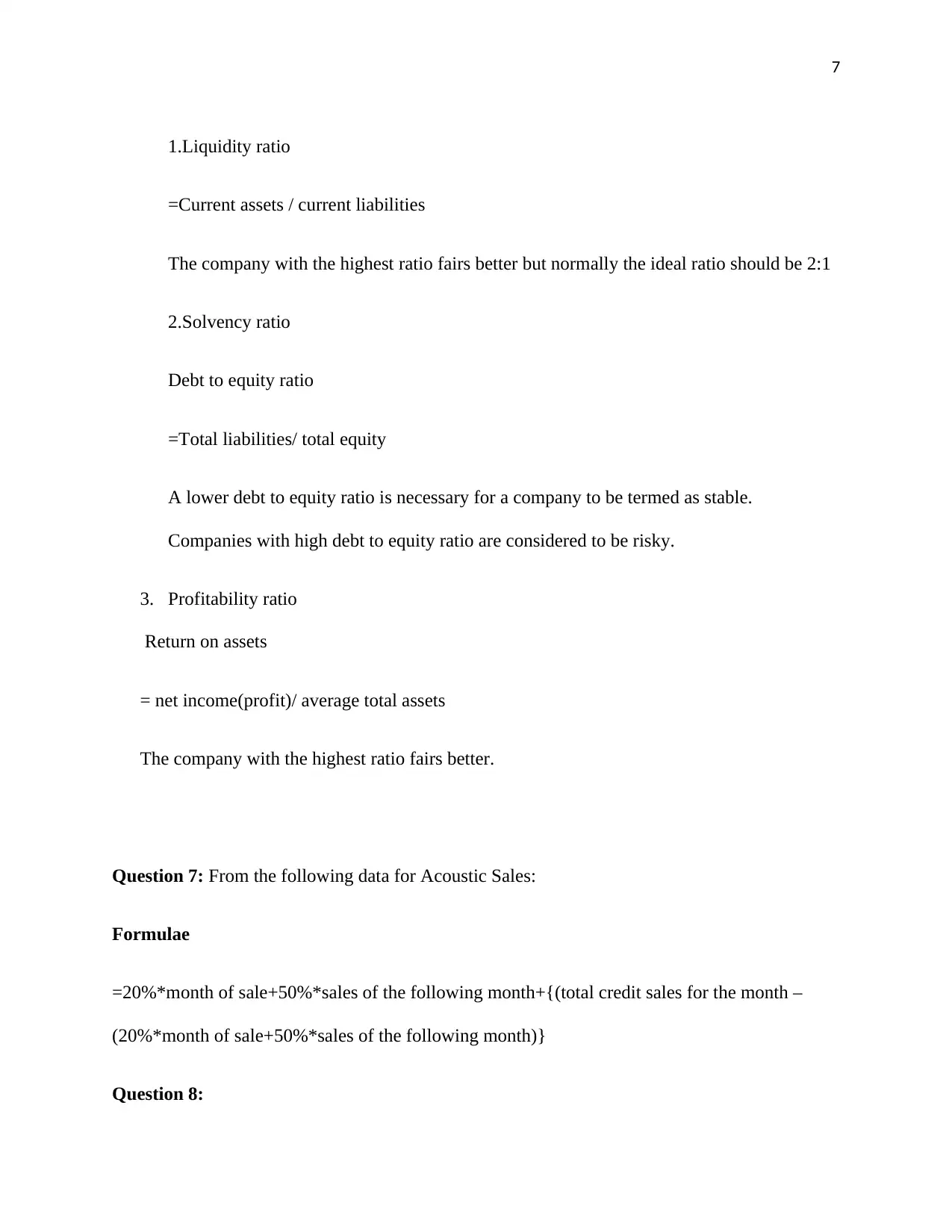
7
1.Liquidity ratio
=Current assets / current liabilities
The company with the highest ratio fairs better but normally the ideal ratio should be 2:1
2.Solvency ratio
Debt to equity ratio
=Total liabilities/ total equity
A lower debt to equity ratio is necessary for a company to be termed as stable.
Companies with high debt to equity ratio are considered to be risky.
3. Profitability ratio
Return on assets
= net income(profit)/ average total assets
The company with the highest ratio fairs better.
Question 7: From the following data for Acoustic Sales:
Formulae
=20%*month of sale+50%*sales of the following month+{(total credit sales for the month –
(20%*month of sale+50%*sales of the following month)}
Question 8:
1.Liquidity ratio
=Current assets / current liabilities
The company with the highest ratio fairs better but normally the ideal ratio should be 2:1
2.Solvency ratio
Debt to equity ratio
=Total liabilities/ total equity
A lower debt to equity ratio is necessary for a company to be termed as stable.
Companies with high debt to equity ratio are considered to be risky.
3. Profitability ratio
Return on assets
= net income(profit)/ average total assets
The company with the highest ratio fairs better.
Question 7: From the following data for Acoustic Sales:
Formulae
=20%*month of sale+50%*sales of the following month+{(total credit sales for the month –
(20%*month of sale+50%*sales of the following month)}
Question 8:
Paraphrase This Document
Need a fresh take? Get an instant paraphrase of this document with our AI Paraphraser
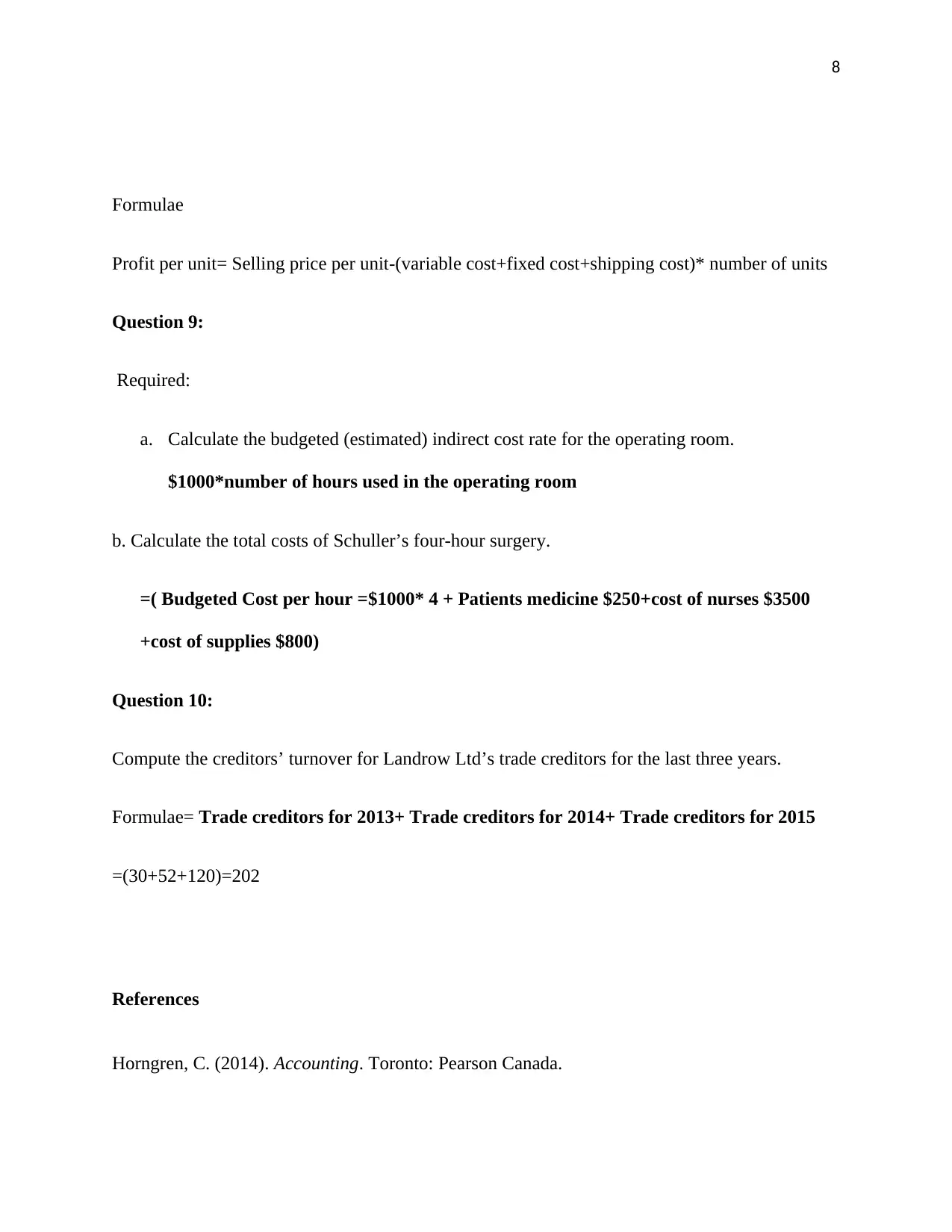
8
Formulae
Profit per unit= Selling price per unit-(variable cost+fixed cost+shipping cost)* number of units
Question 9:
Required:
a. Calculate the budgeted (estimated) indirect cost rate for the operating room.
$1000*number of hours used in the operating room
b. Calculate the total costs of Schuller’s four-hour surgery.
=( Budgeted Cost per hour =$1000* 4 + Patients medicine $250+cost of nurses $3500
+cost of supplies $800)
Question 10:
Compute the creditors’ turnover for Landrow Ltd’s trade creditors for the last three years.
Formulae= Trade creditors for 2013+ Trade creditors for 2014+ Trade creditors for 2015
=(30+52+120)=202
References
Horngren, C. (2014). Accounting. Toronto: Pearson Canada.
Formulae
Profit per unit= Selling price per unit-(variable cost+fixed cost+shipping cost)* number of units
Question 9:
Required:
a. Calculate the budgeted (estimated) indirect cost rate for the operating room.
$1000*number of hours used in the operating room
b. Calculate the total costs of Schuller’s four-hour surgery.
=( Budgeted Cost per hour =$1000* 4 + Patients medicine $250+cost of nurses $3500
+cost of supplies $800)
Question 10:
Compute the creditors’ turnover for Landrow Ltd’s trade creditors for the last three years.
Formulae= Trade creditors for 2013+ Trade creditors for 2014+ Trade creditors for 2015
=(30+52+120)=202
References
Horngren, C. (2014). Accounting. Toronto: Pearson Canada.
1 out of 8
Related Documents
Your All-in-One AI-Powered Toolkit for Academic Success.
+13062052269
info@desklib.com
Available 24*7 on WhatsApp / Email
![[object Object]](/_next/static/media/star-bottom.7253800d.svg)
Unlock your academic potential
Copyright © 2020–2025 A2Z Services. All Rights Reserved. Developed and managed by ZUCOL.





